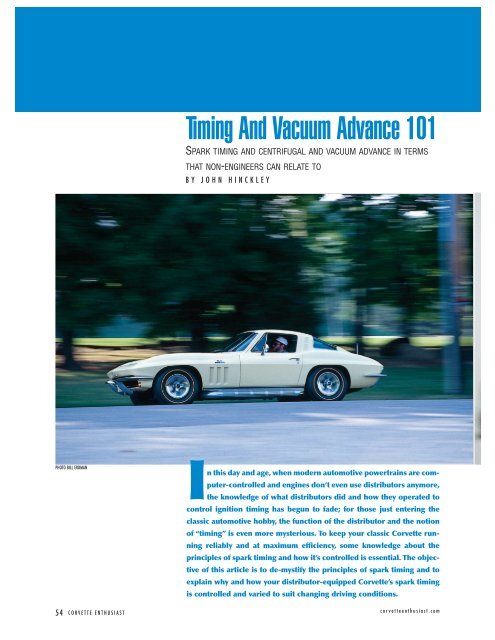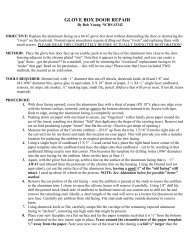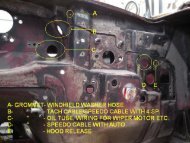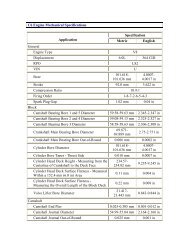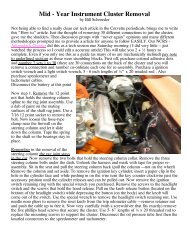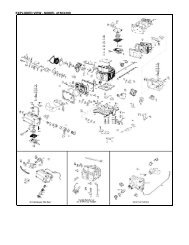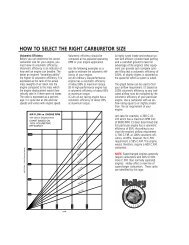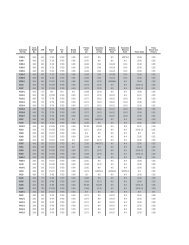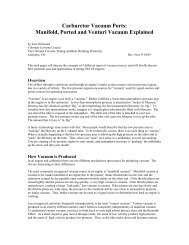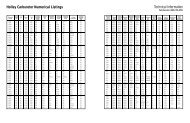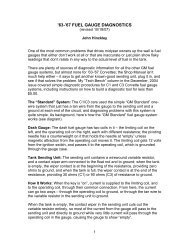Timing And Vacuum Advance 101
Timing And Vacuum Advance 101
Timing And Vacuum Advance 101
Create successful ePaper yourself
Turn your PDF publications into a flip-book with our unique Google optimized e-Paper software.
<strong>Timing</strong> <strong>And</strong> <strong>Vacuum</strong> <strong>Advance</strong> <strong>101</strong><br />
SPARK TIMING AND CENTRIFUGAL AND VACUUM ADVANCE IN TERMS<br />
THAT NON-ENGINEERS CAN RELATE TO<br />
B Y J O H N H I N C K L E Y<br />
PHOTO BILL ERDMAN<br />
In this day and age, when modern automotive powertrains are computer-controlled<br />
and engines don’t even use distributors anymore,<br />
the knowledge of what distributors did and how they operated to<br />
control ignition timing has begun to fade; for those just entering the<br />
classic automotive hobby, the function of the distributor and the notion<br />
of “timing” is even more mysterious. To keep your classic Corvette running<br />
reliably and at maximum efficiency, some knowledge about the<br />
principles of spark timing and how it’s controlled is essential. The objective<br />
of this article is to de-mystify the principles of spark timing and to<br />
explain why and how your distributor-equipped Corvette’s spark timing<br />
is controlled and varied to suit changing driving conditions.<br />
54 C O R V E T T E E N T H U S I A S T c o r v e t t e e n t h u s i a s t . c o m
When someone says their initial timing is set at 10 degrees,<br />
that means the distributor is set to fire the spark plugs<br />
when the crankshaft is 10 degrees of rotation before the piston<br />
reaches top dead center, which is 10 degrees of advance.<br />
I won’t get into the gory details of<br />
combustion theory, but let’s understand<br />
a little about what happens as the piston<br />
is traveling upward on the compression<br />
stroke toward the point where the spark<br />
plug “lights the fire.” Before we light the<br />
fire, let’s talk a little about what we’re<br />
lighting – the fuel/air mixture that’s been<br />
metered by the carburetor and atomized<br />
in the intake manifold as it heads for<br />
each cylinder’s intake valve.<br />
FUEL/AIR MIXTURE AND “BURN<br />
RATE”: At idle and steady cruising<br />
speed, the load on the engine is low,<br />
and the air/fuel mixture is “lean” (more<br />
air/less fuel); when accelerating, the<br />
load on the engine is higher, and it’s fed<br />
a “rich” air/fuel mixture (more fuel/less<br />
air). These are two very different conditions,<br />
as a lean mixture burns relatively<br />
slowly, and a rich mixture burns faster.<br />
Remember this distinction – it’s a key<br />
factor in ignition timing.<br />
Back in the cylinder, with the<br />
piston rising and compressing the air/fuel<br />
mixture, the idea is to fire the spark plug<br />
at just the right moment such that the<br />
mixture is ignited (starting the “burn,” as<br />
the flame front proceeds across the<br />
cylinder) and the rapidly expanding<br />
gases reach peak cylinder pressure just<br />
after the piston reaches TDC (top dead<br />
center), exerting maximum force to push<br />
the piston down on the power stroke for<br />
maximum efficiency.<br />
SPARK TIMING: Referring back to the<br />
burn rate comparison, slower-burning<br />
lean mixtures need to have the “fire lit”<br />
earlier in the compression stroke<br />
(because they take longer to reach peak<br />
cylinder pressure) than faster-burning<br />
rich mixtures (which take less time to<br />
reach peak cylinder pressure). With<br />
either mixture condition, the objective<br />
is to reach peak cylinder pressure at<br />
exactly the same point after TDC, which<br />
means they have to be “lit” at different<br />
points during the piston’s upward travel<br />
1<br />
1 Here’s the distributor, that wondrous device that hides<br />
back there in the dark under your ignition shielding<br />
and contains the two totally independent, but<br />
complementary, spark-advance systems that determine<br />
how your Corvette performs.<br />
PHOTO JOHN HINCKLEY<br />
2 This is the centrifugal advance mechanism that hides<br />
under the rotor – the “autocam pivoting weights,” and<br />
tension springs. The faster it spins, the more the weights<br />
move outward, advancing the spark timing.<br />
PHOTO JOHN HINCKLEY<br />
2 3<br />
3 The pin and slot in the “autocam” that limits maximum<br />
centrifugal advance weight travel is visible directly<br />
above the end of the condenser.<br />
PHOTO JOHN HINCKLEY<br />
c o r v e t t e e n t h u s i a s t . c o m<br />
C O R V E T T E E N T H U S I A S T 55
4 Two different sets of centrifugal advance weights and<br />
three different strengths of tension springs are shown.<br />
How these are combined determines the “advance<br />
curve” for each specific engine combination.<br />
PHOTO JOHN HINCKLEY<br />
5 A typical vacuum-advance distributor, showing the<br />
vacuum diaphragm on the right and the centrifugal<br />
advance mechanism at the top. These two systems are<br />
independent, but work together.<br />
PHOTO JOHN HINCKLEY<br />
– this is what “spark timing” is all about<br />
– managing the point at which the spark<br />
plug fires under different operating<br />
conditions. This point is expressed as<br />
“spark advance” in degrees of crankshaft<br />
rotation before the piston reaches<br />
top dead center. When someone says<br />
their initial timing is set at 10 degrees,<br />
that means the distributor is set to fire<br />
the spark plugs when the crankshaft is<br />
10 degrees of rotation before the piston<br />
reaches top dead center, which is 10<br />
degrees of advance. This is the “initial”<br />
or “base” spark timing which is checked<br />
and set at idle during a traditional tune-up<br />
(with the vacuum advance disconnected);<br />
it’s fixed at the point where it’s set by<br />
clamping down the distributor holddown<br />
bolt, and doesn’t change – it’s<br />
always there.<br />
EARLY SPARK TIMING: In the days<br />
of the simple, low-compression, inefficient<br />
Model T, spark advance was set<br />
manually to a fixed level with a lever on<br />
the steering column. About all the<br />
driver did was to “retard” (delay) the<br />
spark timing while turning the crank to<br />
start the engine, then move the lever to<br />
“advance” the spark timing once the<br />
engine was running. If the driver forgot<br />
to retard the spark when cranking and<br />
left the lever in the advanced position,<br />
the engine could “kick back” while the<br />
operator turned the crank to start the<br />
engine, which could result in a broken<br />
arm (an unforgettable lesson in spark<br />
timing). Once the engine was running,<br />
the operator could vary the spark<br />
advance with the lever for best performance<br />
(such as it was), or just leave it alone<br />
(which most operators chose to do).<br />
With that big, low-compression, slowrunning,<br />
low-powered engine,<br />
little damage could be done by improperly<br />
setting the spark advance.<br />
Fast-forward to the 1960s and<br />
high-compression 350-horsepower<br />
Corvette engines howling at 6500 rpm.<br />
Suddenly the spark timing equation is<br />
much more complex, and spark timing<br />
errors can result in scattering expensive<br />
engine parts all over the street at one<br />
extreme, and poor performance and<br />
fuel economy at the other extreme. An<br />
automatic device has to recognize the<br />
entire spectrum of operating conditions<br />
and manage the complexities of spark<br />
timing in a manner completely<br />
independent of, and transparent to, the<br />
driver, who has other things to keep him<br />
occupied – like traffic, flashing blue<br />
lights in his mirrors, etc.<br />
THE DISTRIBUTOR AND ADVANCE:<br />
This wondrous device that handles all<br />
that work is the distributor, which lives<br />
quietly in the dark, at the back of the<br />
engine, hidden forever under the<br />
Corvette’s ignition shielding, demanding<br />
only an occasional set of points, a<br />
condenser, and a rotor to continue<br />
doing its job. Let’s talk about the two<br />
different ways the distributor manages<br />
spark timing while you’re watching<br />
traffic and grabbing gears – centrifugal<br />
advance and vacuum advance.<br />
The centrifugal advance mechanism<br />
under the rotor in the distributor<br />
advances spark timing based solely on<br />
engine rpm (it’s driven at half crankshaft<br />
speed); a pair of weights pivots on pins,<br />
retained by little coil springs. The faster<br />
the shaft turns, the more the weights<br />
tend to pivot outward (centrifugal<br />
force), and the rate at which they move<br />
outward is controlled by the tension of<br />
the little springs. Lighter springs let<br />
them move fully outward at relatively<br />
low shaft rpm, and stronger springs<br />
require higher shaft rpm for full<br />
outward movement. The pointed “tail”<br />
of the weights, at the pivot end, bear<br />
against a cam (called the “autocam”)<br />
attached to the top of the distributor<br />
shaft and, as the weights move<br />
outward, the eight-sided cam that<br />
opens and closes the contact points<br />
4 5<br />
(which trigger the coil to fire the spark<br />
plugs when the points open) is<br />
“advanced” so it opens the points<br />
earlier than when the weights are fully<br />
retracted (as they are at idle). In most<br />
distributors, this mechanism provides<br />
up to 20-25 (crankshaft) degrees of<br />
spark advance when the weights are<br />
fully extended. The maximum advance<br />
this system can provide is limited by<br />
a bushing installed over a pin, which<br />
moves in a slot in the lower plate of<br />
the autocam. The system is designed so<br />
that the weights don’t begin to move<br />
until slightly above normal idle rpm,<br />
so the initial timing can be set<br />
accurately without any influence from<br />
the centrifugal advance mechanism.<br />
CENTRIFUGAL ADVANCE CALIBRATIONS:<br />
There are many different calibrations of<br />
weight configurations and spring<br />
tensions specified for production<br />
Corvette distributors, depending on the<br />
performance level of the engine, manual<br />
or automatic transmission, etc. The<br />
points between the rpm at which the<br />
weights begin to move and the rpm at<br />
which they’re fully extended, providing<br />
maximum advance, is referred to as the<br />
“centrifugal advance curve,” which is<br />
tailored to each engine combination.<br />
The key point to remember here is that<br />
the centrifugal advance mechanism<br />
advances and retards spark timing<br />
in response only to engine rpm, and<br />
nothing else. Its function is to advance<br />
spark timing as engine rpm increases.<br />
As upward piston speed increases with<br />
rpm, effectively shortening the time for<br />
the compression stroke, the spark has to<br />
fire sooner, as the air/fuel mixture still<br />
takes the same amount of time to burn<br />
as it does at lower rpm. In effect, the<br />
centrifugal advance mechanism handles<br />
only the basic physics of lighting the fire<br />
sooner at higher rpm so peak cylinder<br />
56 C O R V E T T E E N T H U S I A S T c o r v e t t e e n t h u s i a s t . c o m
6 A typical vacuum advance unit. The rod at the bottom<br />
is connected to the vacuum diaphragm, and connects to<br />
the movable points breaker plate at the other end. When<br />
vacuum is applied, it advances the breaker plate.<br />
7 The vacuum advance unit, attached with two screws to<br />
the distributor body. The tip of its actuating rod is visible<br />
at the left, protruding through the movable breaker<br />
plate.<br />
pressure is still reached at the same<br />
point just after TDC.<br />
Now we have the basic physics<br />
handled, but we still need another system<br />
to manage spark advance based on all<br />
the variations of driving conditions and<br />
engine load variations experienced in<br />
normal operation. This is handled by the<br />
vacuum advance system.<br />
VACUUM ADVANCE: The vacuum<br />
advance system consists of a vacuum<br />
diaphragm mounted on the distributor<br />
body. The diaphragm is spring-loaded in<br />
the zero-advance position, and has a rod<br />
that connects to a hole in the breaker<br />
plate, which is the movable plate the<br />
points are mounted on. When vacuum is<br />
applied to the diaphragm, it pulls on the<br />
rod, which in turn pulls on the breaker<br />
plate, rotating it with respect to the eightsided<br />
cam on the distributor shaft which<br />
opens and closes the points. When<br />
viewed from the top, the distributor shaft<br />
(and the eight-sided cam for the points)<br />
turns clockwise. When the vacuum<br />
advance rod pulls on the breaker plate, it<br />
rotates the breaker plate (and the points)<br />
counter-clockwise, which “advances”<br />
the opening of the points (triggering the<br />
coil to fire the spark plugs). A typical<br />
vacuum advance unit, when fully<br />
deployed, will add about 15 (crankshaft)<br />
degrees of spark advance over and<br />
above what the distributor’s centrifugal<br />
advance system is providing at the<br />
moment, which depends on engine rpm.<br />
They are two independent systems, but<br />
they work together to provide the correct<br />
amount of spark advance.<br />
CONTROLLING VACUUM ADVANCE:<br />
Let’s look at how the vacuum advance<br />
system is controlled. Referring back<br />
again to burn rates, remember that lean<br />
mixtures burn slower and rich mixtures<br />
burn faster. Engine load conditions (idle,<br />
6 7<br />
steady cruise, acceleration) result in<br />
how lean or rich the air/fuel mixture is<br />
(the carburetor handles this), and the<br />
best indicator of engine load is intake<br />
manifold vacuum. At idle and steady<br />
cruise, engine load is low, and intake<br />
manifold vacuum is high due to the<br />
nearly closed carburetor throttle plates.<br />
Under acceleration, the throttle plates<br />
open wider, and intake manifold<br />
vacuum drops. It is essentially zero at<br />
wide-open throttle. As a result, intake<br />
manifold vacuum is a “free” indicator of<br />
engine load, which correlates nicely<br />
with fuel mixture being supplied – lean<br />
mixture at high vacuum, and rich<br />
mixture at low vacuum.<br />
At idle, the engine needs additional<br />
spark advance in order to fire the lean<br />
(and exhaust-diluted) idle fuel/air<br />
mixture earlier in the cycle in order to<br />
develop maximum cylinder pressure at<br />
the proper point after TDC for efficiency,<br />
so the vacuum advance unit is activated<br />
by the high manifold vacuum, and adds<br />
another 15 degrees of spark advance on<br />
top of the fixed initial timing setting. For<br />
example, if your initial timing is set at<br />
10 degrees, at idle it’s actually 25<br />
degrees with the vacuum advance<br />
connected (a properly calibrated<br />
centrifugal advance mechanism will not<br />
have started to move yet at idle rpm).<br />
The same thing occurs under<br />
steady highway cruise conditions. The<br />
mixture is lean, takes longer to burn, the<br />
load on the engine is low (it takes only<br />
about 40 horsepower to cruise at<br />
50mph) and the manifold vacuum is<br />
high, so the vacuum advance unit is<br />
again deployed and adds 15 degrees<br />
of spark advance over and above<br />
whatever the distributor centrifugal<br />
advance mechanism is providing at that<br />
engine rpm. If you had a timing light<br />
connected so you could see it as you<br />
cruise down the highway, you’d see<br />
about 45-50 degrees of spark advance –<br />
your fixed initial advance of 10 degrees,<br />
20-25 degrees provided by the<br />
centrifugal advance mechanism, and<br />
the 15 degrees added by the vacuum<br />
advance unit.<br />
When you accelerate, the fuel/air<br />
mixture is immediately enriched (by the<br />
accelerator pump, power valve, metering<br />
rod piston, etc.), and that rich mixture<br />
now burns faster and doesn’t need the<br />
additional spark advance anymore.<br />
When the throttle plates open, the<br />
manifold vacuum drops, and the<br />
vacuum advance unit diaphragm<br />
retracts to its zero position, “retarding”<br />
the spark timing back to what is being<br />
provided at that moment by the fixed<br />
initial timing and the centrifugal<br />
advance mechanism. The vacuum<br />
advance doesn’t come back into play<br />
until you back off the gas and manifold<br />
vacuum increases again as you return to<br />
steady-state cruise, when the mixture<br />
again becomes lean and needs more<br />
spark advance for fuel efficiency.<br />
VACUUM ADVANCE CALIBRATION:<br />
There are also many different calibrations<br />
of vacuum advance units. Some begin<br />
to deploy at different vacuum levels<br />
than others, and some provide more<br />
degrees of advance when fully deployed<br />
than others. The original calibration was<br />
selected based on the intake manifold<br />
vacuum characteristics of that particular<br />
engine/transmission combination and<br />
how it was expected to perform in daily<br />
use. <strong>Vacuum</strong> advance units were<br />
connected to full manifold vacuum for<br />
decades. In the late ’60s and early ’70s,<br />
when emissions began to become an<br />
issue, many were instead connected to<br />
“ported” or “timed” vacuum sources.<br />
We’ll discuss this aberration a little later.<br />
THE ADVANCE COMBINATION:<br />
Now we have two different advance<br />
systems working independently, but<br />
complementing each other, to manage<br />
spark timing – centrifugal, based on<br />
c o r v e t t e e n t h u s i a s t . c o m<br />
C O R V E T T E E N T H U S I A S T 57
HOT BACK<br />
ISSUES<br />
SEPTEMBER 2003<br />
A Mid-Generation Machine: This ‘91<br />
is still a lot of fun. MTI’S 2002 Z06,<br />
Hot Products for Sharks, Cover<br />
Protection for your Corvette, 1953<br />
Corvette’s inaugural season,<br />
Concept C60 prototype, Corvette<br />
Cooling System Basics, ‘57<br />
Corvette SS, A Walk through the<br />
Bowling Green Assembly Plant, ‘66<br />
427, ‘82 Collector Edition<br />
AUGUST 2003<br />
‘63 Vette split-window coupe, the<br />
Last C-5 with special Lemans<br />
Commemorative Edition, Stu Hayner,<br />
Systems approach to LS1 engine<br />
modifications, Corvette Grassroots,<br />
Puncture repairs for speed rated<br />
tires, ‘95 Corvette, John & Burt<br />
Greenwood, ‘75 Coupe, ‘59 Vette,<br />
C5 Birthday bash, Disc Brakes,<br />
Herb Fishel, Gif Hufstader<br />
JULY 2003<br />
Building on Perfection: Subtle<br />
improvements to C5 rear, Exhaust<br />
systems balance, ‘62 Vette,<br />
Magnacharger Kit, 50 Unsung<br />
Corvette Heroes, ‘93 Red Coupe,<br />
Elkhart ‘72 Coupe, K40 Laser<br />
DefuserPlus, ‘63 Sting Ray,<br />
Modified ‘98<br />
Back Issues<br />
Retail $6.00 AA* $4.00 per issue<br />
MAGAZINE STORAGE BOX<br />
Keep all your back issues<br />
organized and and tidy in this<br />
handsome 11 3 ⁄4” x 4” x 9”<br />
cardboard storage box.<br />
A portion of box includes a<br />
preprinted area to list contents.<br />
ITEM RETAIL AA*<br />
XMAGBOX $7.99 $5.99<br />
To order call 1-800-572-6885<br />
www.amosadvantage.com<br />
AA* prices apply to paid subscribers of Amos Automotive titles.<br />
Shipping & Handling:<br />
U.S. - 10% of order total - Minimum $5.00 Maximum $25.00<br />
Canada - 10% of order total - Minimum $10.00 Maximum $35.00<br />
Foreign orders are shipped via DHL and billed actual freight.<br />
P.O. Box 828 Sidney OH 45365-828<br />
engine rpm, and vacuum, based on engine load and operating conditions. The<br />
centrifugal advance system is purely mechanical and is only rpm-sensitive; nothing<br />
changes it except engine rpm. <strong>Vacuum</strong> advance, on the other hand, responds<br />
instantly to engine load and rapidly changing operating conditions, providing the<br />
correct amount of spark advance at any point in time, to deal with both lean and<br />
rich mixture conditions.<br />
By today’s engine management terms, this was a relatively crude mechanical<br />
system, but it did a good job of optimizing engine efficiency, throttle response, fuel<br />
economy, and idle cooling, with absolutely zero negative effect on wide-open<br />
throttle performance, as the vacuum advance is inoperative under that condition.<br />
In modern cars with computerized engine controllers, all those sensor inputs to<br />
the computer change both spark timing and fuel/air mixture 50 to 100 times per<br />
second, and we don’t even have a distributor anymore – it’s all electronic.<br />
“PORTED” VACUUM: Now to the widely misunderstood manifold vs. ”ported”<br />
vacuum aberration. After 30-plus years of controlling vacuum advance systems with<br />
full manifold vacuum, that “free” indicator of engine load and fuel mixture, along<br />
came early emission control requirements (seven years before catalytic converter<br />
technology was introduced), and all manner of crude band-aid systems were<br />
introduced to try to reduce hydrocarbons and oxides of nitrogen in the exhaust<br />
stream. One of these crude, but effective systems was GM’s Air Injection Reactor<br />
(A.I.R.) system, which pumped fresh air into the exhaust ports to “afterburn”<br />
pollutants in the exhaust manifolds. The key to making this system work at<br />
maximum efficiency was retarded spark at idle; with retarded idle spark timing, the<br />
“burn” begins late, and is not complete when the exhaust valve opens, which does<br />
two things that were important for emissions. The incomplete burn reduced<br />
combustion chamber temperatures, which reduced the formation of oxides of<br />
nitrogen (NOX), and the significant increase in exhaust gas temperature ensured<br />
rapid “light-off” and combustion of the hydrocarbons in the exhaust gas stream<br />
when the fresh, oxygen-carrying air was introduced from the air pump.<br />
As a result, these engines ran poorly, and an enormous amount of wasted heat<br />
energy was transferred through the exhaust port walls into the coolant, causing<br />
them to “run hot” at idle; cylinder pressure fell off, engine temperatures went up,<br />
combustion efficiency went down the drain, and fuel economy went down with it.<br />
“Ported <strong>Vacuum</strong>” was easy to implement – they just moved the distributor vacuum<br />
port orifice in the carburetor from below the throttle plate (where it was exposed to<br />
full manifold vacuum) to above the throttle plate, where it was exposed to manifold<br />
vacuum only after the throttle plate opened. This meant that the vacuum advance<br />
was inoperative at idle (retarding idle spark timing from its optimum value), and<br />
these applications also had very low initial timing settings; they were usually set at<br />
four degrees before TDC or less, and some even had initial timing settings as much<br />
as two degrees after TDC. The vacuum advance still worked at highway cruise, but<br />
not at idle, which caused all manner of problems. “Ported <strong>Vacuum</strong>” was strictly an<br />
early pre-converter crude emissions strategy and nothing more. Don’t believe<br />
anyone who tells you that ported vacuum is a good thing for performance and<br />
drivability – it’s not. Anyone with a street-driven car without manifold-connected<br />
vacuum advance is sacrificing idle cooling, throttle response, engine efficiency, and<br />
fuel economy, probably because they don’t understand what vacuum advance is,<br />
how it works, and what it’s for. There are lots of long-time experienced mechanics<br />
who don’t understand the principles and operation of vacuum advance either, so<br />
they’re not alone.<br />
THE BOTTOM LINE: Now that we’ve covered the why’s and how’s of spark<br />
timing and its control systems, you can appreciate what’s going on underneath your<br />
ignition shielding and how it affects performance and drivability. Checking the<br />
operation of the centrifugal and vacuum advance systems during periodic maintenance<br />
and tune-ups can pay real dividends that you can feel in the seat of your<br />
pants. Well, you say, “How do I do that?” Tune in next month, when we’ll show you<br />
how to check out those systems, how to “map” your advance curves against their<br />
design specifications and verify proper operation, and pass along some simple tips<br />
and techniques for improving your Corvette’s performance by “tweaking” its<br />
advance systems for peak efficiency.<br />
■<br />
58 C O R V E T T E E N T H U S I A S T c o r v e t t e e n t h u s i a s t . c o m


